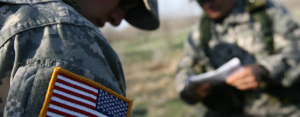Editor-in-chief
Lindsey Wafford doesn’t want to serve in a combat position.
But thanks to the lifting of the ban on women serving in combat, this junior cadet from Steinwenden, Germany, can if she ever changes her mind.
Wafford is in her third year in Baylor’s ROTC program. Wafford said that at the end of the year, she will attend a summer school where her skills will be evaluated and she will be told what her military career will entail, including which branch she’ll be placed in and whether she’ll serve active duty.
A math major, Wafford said she hopes to become a military intelligence officer.
“I’m not exactly interested in myself going into a combat position, but I know that it’s a huge issue for a lot of people,” Wafford said.
Although she doesn’t want a combat position herself, Wafford said she has friends who are qualified to go into such positions.
“I personally believe it’s a great idea,” she said.
Although serving in combat isn’t her chosen career field, the ban’s lifting might still affect her if she serves overseas.
“I think it would affect any female who goes into the military. You’re over there, you’re carrying a weapon,” she said. “You have to be prepared to lead a mission at any time.”
Wafford said she believes this is especially true due to the areas the military is currently deployed.
“When you’re deployed overseas there’s always a chance you’ll be near a combat zone. There’s always strikes anywhere.”
Highland, Mich., junior Danny Litchfield has been in the ROTC for three years. Litchfield, who wants to serve in a combat position, says he doesn’t mind serving with women, but that wasn’t always the case.
“I used to not be for it,” he said. Though meeting and working with women in the ROTC has since changed his mind.
“I’ve seen some tremendous women serve,” Litchfield said. Plus, he added, conditions in the military are different than they used to be. Litchfield said he believes that due to current tactics, technology and training, it is no longer fair for them to be excluded.
The only situation he worries about, Litchfield said, would be in extreme cases where one female soldier might be alone with an injured male soldier and be unable to physically carry him back to a safe location.
However, he said, the same potential for danger exists if a man in the same situation can’t carry the injured man either, and he remains confident that military training will be able to overcome any such potential problems.
“It is our duty to do our job,” Litchfield said. “I don’t care who is standing next to me. I will follow orders. As long as that person doesn’t impede our ability to complete our mission, I don’t care who it is.”
Wafford echoed Litchfield’s point, saying she thinks it is a great idea for women to serve in combat if they can pass the physical requirements.
Litchfield said he believes members of the military will handle the news well.
“I have seen a lot of maturity from cadets to officers. I believe that maturity will be shown when it comes to women,” he said.







